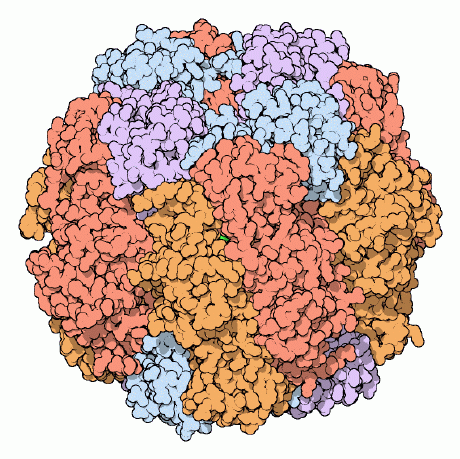|
Inhaltsübersicht | Nanomaschinen | Moleküle | Programme | Kurse | Fun | Links |
||
| > |
Rubisco (Ribulose Bisphosphate Carboxylase/Oxygenase)
Fixing Carbon
Carbon is essential to life. All of our molecular machines are built around a central scaffolding of organic carbon. Unfortunately, carbon in the earth and atmosphere is locked in highly oxidized forms, such as carbonate minerals and carbon dioxide gas. In order to be useful, this oxidized carbon must be "fixed" into more organic forms, rich in carbon-carbon bonds and decorated with hydrogen atoms. Powered by the energy of sunlight, plants perform this central task of carbon fixation.
Inside plant cells, the enzyme ribulose bisphosphate carboxylase/oxygenase (rubisco) forms the bridge between life and the lifeless, creating organic carbon from the inorganic carbon dioxide in the air. Rubisco takes carbon dioxide and attaches it to ribulose bisphosphate, a short sugar chain with five carbon atoms. Rubisco then clips the lengthened chain into two identical phosphoglycerate pieces, each with three carbon atoms. Phosphoglycerates are familiar molecules in the cell, and many pathways are available to use it. Most of the phosphoglycerate made by rubisco is recycled to build more ribulose bisphosphate, which is needed to feed the carbon-fixing cycle. But one out of every six molecules is skimmed off and used to make sucrose (table sugar) to feed the rest of the plant, or stored away in the form of starch for later use.
Slow and Steady
In spite of its central role, rubisco is remarkably inefficient. As enzymes go, it is painfully slow. Typical enzymes can process a thousand molecules per second, but rubisco fixes only about three carbon dioxide molecules per second. Plant cells compensate for this slow rate by building lots of the enzyme. Chloroplasts are filled with rubisco, which comprises half of the protein. This makes rubisco the most plentiful single enzyme on the Earth.
Rubisco also shows an embarrassing lack of specificity. Unfortunately, oxygen molecules and carbon dioxide molecules are similar in shape and chemical properties. In proteins that bind oxygen, like myoglobin, carbon dioxide is easily excluded because carbon dioxide is slightly larger. But in rubisco, an oxygen molecule can bind comfortably in the site designed to bind to carbon dioxide. Rubisco then attaches the oxygen to the sugar chain, forming a faulty oxygenated product. The plant cell must then perform a costly series of salvage reactions to correct the mistake.
Next: Sixteen Chains in One
Last changed by: A.Honegger,
